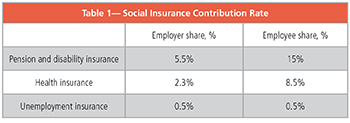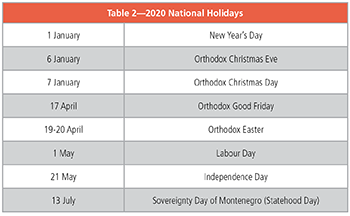
Montenegro, meaning “black mountain,” is a country of about 600,000 people located in Southeastern Europe. It is bordered by Albania, Bosnia and Herzegovina, Croatia, Serbia, and the Adriatic Sea, with Italy on the other side. A former republic of Yugoslavia, Montenegro later joined in federation with Serbia until 2006, when it became an independent nation.
Montenegro is transitioning to a market economy, and most of its state-owned companies have been privatized, including 100% of its banking, telecommunications, and oil distribution systems. The country joined the World Bank and International Monetary Fund in 2007 and the World Trade Organization (WTO) in 2011. It is in negotiations to join the European Union.
The country has a Mediterranean climate, with hot, dry summers and cold winters that bring heavy inland snowfall.
Applicable Laws
The main laws that regulate employment include the following:
- Labour Law
- Law on Pension and Health Insurance
- Law on Salaries of Civil Servants and State Employees
- Law on Contributions of Mandatory Social Insurance
- Law on Personal Income Tax
- Collective agreement signed between labour union and the government
Social Insurance Contributions
 The rates for social insurance contributions can be seen in Table 1 and are applied to the gross monthly salary.
The rates for social insurance contributions can be seen in Table 1 and are applied to the gross monthly salary.
Other contributions and dues paid by the employer include the following:
- Labour Fund—0.2%
- Economic Chamber—0.27%
- City Surtax—15% (levied by municipalities, calculated as 15% on the individual income tax)
Personal Income Tax
The personal income tax rate is 9%. Personal income tax is imposed on the full net salary amount.
Employment Procedure
An employment contract is signed in the local language prior to the employee assuming work responsibilities. If the employer fails to sign an employment contract with the employee in writing prior to their assuming work responsibilities, it is considered that the employee has established an employment relationship for an indefinite duration of time as of the date of assuming work responsibilities, should the employee accept that employment. In this case, the employer must sign an employment contract for an indefinite duration within three days from the day of assuming work responsibilities.
The Montenegrin Labour Law recognizes three types of employment:
- Indefinite duration of employment
- Employment for defined period of time
- Short-term employment for occasional engagements such as consultancy
Normal working hours are eight hours a day or 40 hours per week. An employee can conclude multiple part-time employment contracts with more than one employer and thus accumulate a full-time work engagement. An employment contract can be concluded for engagement of less than full time, but not less than one-fourth (10 hours per week) of the full-time hours.
Leave and Holidays
There are several types of leave that may be provided to employees. They include the following:
- Paid Leave—In each calendar year the employee has the right to an annual leave as set by the collective agreement or the employment contract, but the number of total leave days should not be fewer than 20 working days. An employee also has the right to be fully paid during official holidays that are defined by law (see Table 2).
- Sick Leave—Medical doctors issue written recommendations for sick leave. The employer has an obligation to pay 70% of the employee’s gross salary for up to 60 days of sick leave. For sick leave that lasts longer than 60 days, the Health Fund covers 70% of the employee’s gross salary.
- Maternity Leave—Women have the right to be absent for 365 days on maternity leave. The maternity leave starts four weeks before the due date. The employer is obliged to pay the total amount of the employee’s last salary during the maternity leave. In the first 10 days after the payment of the monthly salary, the employer must submit the request form for reimbursement. Reimbursement for an employee on maternity leave is limited to two average national salaries.

Payroll Calculation Procedure
An employee’s monthly net (or gross) salary is determined by the employment contract. The obligatory reports include the following:
- Pay slip
- Report to Tax Office on monthly amount of tax and contributions
- Report to Municipal Office with information on paid taxes and surtax
Termination of Employment
Employment can be terminated by the following:
- Force of law
- A mutual agreement between the employer and the employee
- Unilateral cancellation of the employment contract either by the employer or the employee
An employee will have the right and duty to remain at work for at least 15 days past the day of submitting the notice of cancelling the employment contract, i.e., the decision on termination of employment (notice period), in cases determined by the collective agreement and the employment contract.
Do you like our content? Join the GPMI community to get free education and articles straight to your inbox!

Bojana Vujadinovic is Accounting Manager at Eurofast with more than five years of experience in the accounting field in diverse international environments. She specializes in payroll, financial reporting, financial analysis, accounting, and management. She holds a degree in economics with specialization in accounting and finances. She is a certified International Federation of Accountants (IFAC) accountant.